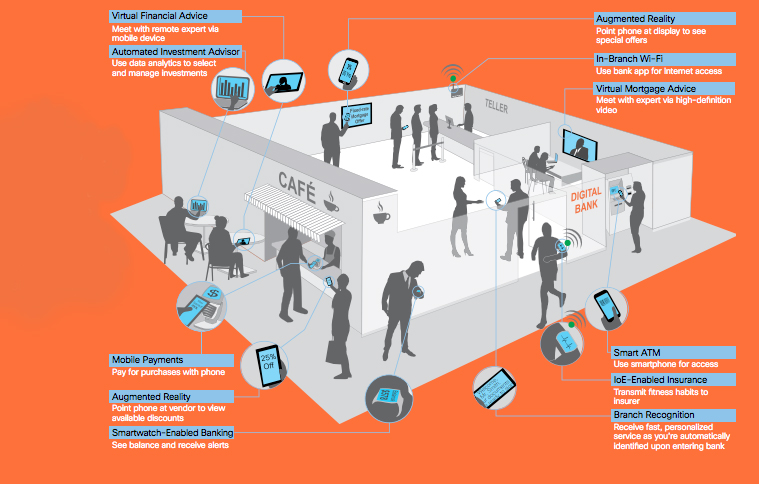
Bank of the Future
We’re farther into the future than Marty McFly ever went. We’ve achieved hover boards, self-tying shoelaces and lots more besides. Great Scott! But if the DeLorean ever returns, everything’s going to look different all over again. Including banking.
How? Plug in the flux extrapolator and let’s go Bank in the Future.
Omnichannel and Beyond
Consumers of all ages increasingly expect elegant and robust digital experiences from all companies, including banks.
Take mobile. The UK is the most active mobile commerce market in Europe, according to Facebook Head of Northern Europe, Steve Hatch. We spend on average 2.5 hours on smartphones per day and projections for our mobile spending are a whopping fifty billion pounds by 2020. Banks aren’t just sitting around waiting to be made irrelevant by this. In fact, a better customer experience and mobile bankers’ 25%-30% additional effectiveness are a couple of reasons they’re finding ways to lead the charge.
Now: While still servicing traditional branch users, many of the UK’s leading financial services institutions have already begun an omnichannel approach. Today’s high-tech branch gives customers the ability to speak to a mortgage adviser, for example, on a HD video link, or even remotely with videoconferencing via smartphone app.
The Future: When you consider that some banks already provide indicative mortgage quotes on property websites (some of which already 3D-map properties), tomorrow’s mortgage adviser could very well pop up as a live hologram during viewing! It’s just one example of how larger banks might behave more contextually and gain access to expanded markets. Expect to see more services white-labelled to other organisations in this way as banking migrates to the Internet of Everything.
Connected Customers
Back in the 20th century, solutions to branch congestion included opening at weekends, and sending customers to clumsy telephone systems and FAQ pages. It was a customer experience that left many of us exasperated, thinking, ‘I just want to speak to a real person.’ To remain innovative, Banks are increasingly turning to fintech start-ups, says Cisco head of financial services solutions and innovation (EMEAR), Simon Blissett.
Now: Across all channels, big data is already translating into better customer qualification and personalised products and services. Bank Simpanan Nasional (BSN) of Malaysia is using virtual teller machines for faster, more efficient service in its branches. The virtual tellers enable the bank to offer tailored advice and services either through a touchscreen or with the help of a bank associate via video. The system uses encrypted electronic signatures. Meanwhile, two Japanese banks —Bank of Tokyo-Mitsubishi UFJ and Mizuho Bank— are taking an even bolder step in virtual teller services by introducing humanoid robots. These friendly machines are not meant to replace human tellers. Instead, they augment human capabilities and free workers for other interactions. Smartphone payments are increasingly common and apps allow cardless ATM access.
The Future: In 2014, McKinsey & Co alluded to a trend: ‘More progressive incumbent banks and financial institutions are already investing heavily in transaction migration, significantly upgrading web and mobile capabilities, creating centres for innovation and testing, and adopting the habits and culture of digitally native companies by, for example, opening up APIs, pursuing agile development, and hackathons.’
Some smartphones already have fingerprint unlocking systems. Could the bank of the future allow you to access ATMs the same way? Might it one day be safe (and accepted) to pay for your shopping with retina scan or voice recognition?
As banks start to integrate their products into the Internet of Everything, the sky is the limit for the banking solutions we might see in future.
https://www.youtube.com/watch?v=S9-LIj04hk0
Trust
Trust is a timeless concept. When we asked what would make respondents most hesitant about using virtual advisory services, security fears topped the list in 10 of the 12 countries surveyed. “When you think about what banks have in terms of data, it is arguably the most intimate portrait of a consumer there is,” says Mark Schwanhausser, Director of Omnichannel Financial Services, Javelin Strategy and Research.
Now: Growing use of tech for financial products is coinciding with a warming of customers’ relationships with their banks, according to research by BT. Banks are using digital technology to regain the advice advantage, close the ‘value gap’ and regain customer trust.
The Future: In some ways perhaps we have to go back to get to the future. Trust and security still go hand in hand today as they always have. As banks migrate more services to the network, their attack surface increases so they need the most effective security embedded.
Trust is also about enabling customers. For example, a growing number believe that expert investment advice does not need to come from an individual human being. Some would be willing to use a service in which analytics — rather than wealth managers — select and manage their investment portfolios. Would you trust AI to manage your fund?
When everything is securely connected, anything is possible.
Tags:


